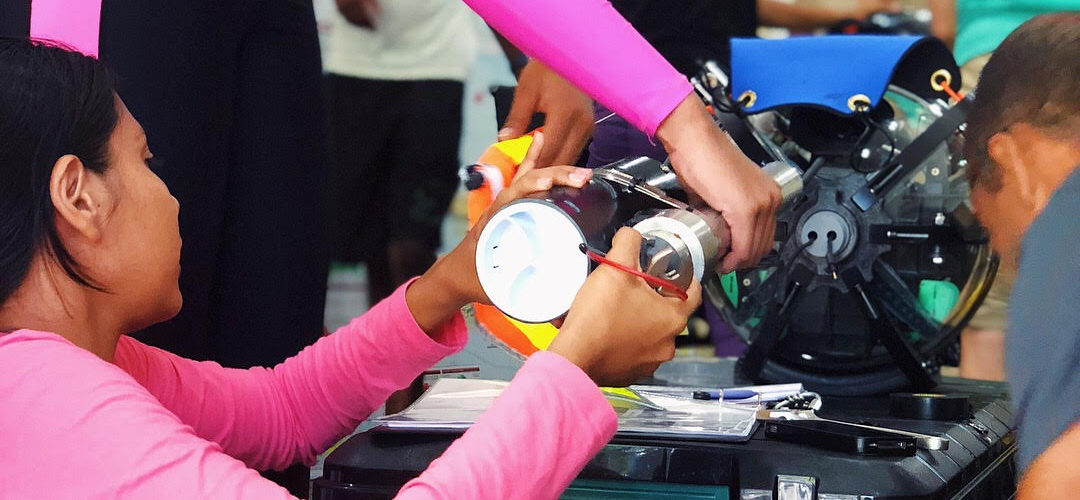In our lab at the MIT Center for Civic Media, much of our work centers around broadening participation in technology design (for example, the Make the Breast Pump Not Suck project). Lately, in collaboration with the MIT Open Ocean Initiative, we have also been thinking about how to broaden participation in scientific discovery. Traditionally, ocean exploration is done by those with formal degrees and access to costly equipment, but in order to fully explore and understand our vast oceans, we need to make it possible for new communities to join this effort.
There is inequity at play when we consider how scientific knowledge is distributed. 70% of nations have deep-sea environments within their maritime zones, yet only 15% of nations have the resources necessary to actually explore what is down in the deep. This can lead to exploitation by numerous industries (e.g. oil and gas, offshore energy, deep sea mining, fishing, etc.), poor resource management decisions, and missed opportunities to make use of undiscovered resources that will support life on land.
Using participatory design approaches, we’re working with the Open Ocean Initiative, National Geographic, and the University of the West Indies on a pilot project to develop training programs for researchers in the nations of Kiribati and Trinidad & Tobago. This August, I joined Diva Amon, Katy Croff Bell, and Alan Turchik in Trinidad & Tobago to explore opportunities for participatory ocean exploration. As part of the pilot phase of My Deep Sea, My Backyard, young researchers are learning how to use low-cost deep-sea drop cameras and teaching their peers how to use them, with the goal of building lasting in-country capacity and passion for exploration.
Our trip began with a large convening organized by Diva — bringing together scientists, engineers, government officials, energy industry stakeholders, conservationists, artists, and students — for a day full of talks about the deep ocean and technologies for exploration, as well as a participatory workshop on future opportunities to better understand the deep sea regions of Trinidad & Tobago. Following the workshop, we held a smaller 3-day workshop to train young researchers how to use the National Geographic low-cost deep-sea drop cameras.



During some of the down-time between training (and waiting for boats to arrive!), we had the opportunity to interview several of the people who participated in the workshop about what motivated them to spend a week with us learning about the deep sea. Our participants had diverse interests, but a shared passion for exploration:
Hannah Lochan, a plant and marine biology student, told us about how she developed an interest in the ocean through a research project she did as an undergraduate. She and her fellow classmates developed fieldwork skills by studying the distribution of hard and soft coral in the Salybia Beach reef of Trinidad. “I’m excited to see how deep we can go with the DropCam!” Hannah told us, explaining her motivations for exploring the deep sea in addition to coastal environments, “We really have no idea what’s out there!”
Raquel Khan Ali, a marine biology and ecology student, told us she’s been drawn to the water ever since she was a child. “I want to know what’s out there,” she said, “things I can’t see, things I really can’t see.” She also described a lack of awareness about career opportunities related to the oceans, and told us how important it is that researchers like Diva Amon — the Trinidadian deep-sea biologist leading My Deep Sea, My Backyard — are bringing knowledge back to Trinidad to motivate more people to explore their own backyards.
Laura-Ashley Henderson, also a marine biology and ecology student, is excited by the opportunity to share research findings from the DropCam more broadly in Trinidad. “Not as many people go to the beach in Trinidad as one may think, they are not as interested as you may expect for an islander,” she told us, “whatever we find out there, I hope it’s interesting enough to get people excited about the ocean,” adding that she wanted more people to begin to see ocean technology and exploration as a possible career path.
Thera Edwards, a Map Curator from the Department of Geography and Geology at the UWI Mona Campus, Jamaica and technical advisor to the Jamaica Conservation and Development Trust, told us about her interest in managing the ocean data that researchers will collect: “it’s not the sexy part, but it’s important…without organizing the data and making it useful, how does anything else happen?” She also described how DropCams and ROVs could help demystify the ocean and make it more accessible: “Before this, ocean exploration seemed like a scary ‘Jacques Cousteau, diving bell, risky thing’…but now there are pieces of equipment that enable you to get information remotely in a relatively safe way.”
Our team is currently synthesizing learnings from this pilot project (along with its sister effort in Kiribati, led by Randi Rotjan and Brian Kennedy) and exploring opportunities to expand the work. A core component of this project is to promote public understanding of and interest in the deep sea — as the project grows, we plan to work with our partners in each country to co-design educational and outreach strategies to include the broader public in ocean exploration efforts. We are also investigating opportunities for the co-design of easy-to-use and accessible technologies for this purpose, including software to facilitate collaborative data analysis, new sensors and sample collection tools, and much more.
If you’d like to learn more about our journey, check out our expedition report on National Geographic OpenExplorer, and our project page on the MIT Media Lab website. This project is supported by the IDB and the National Geographic Society — thank you for making this work possible!




